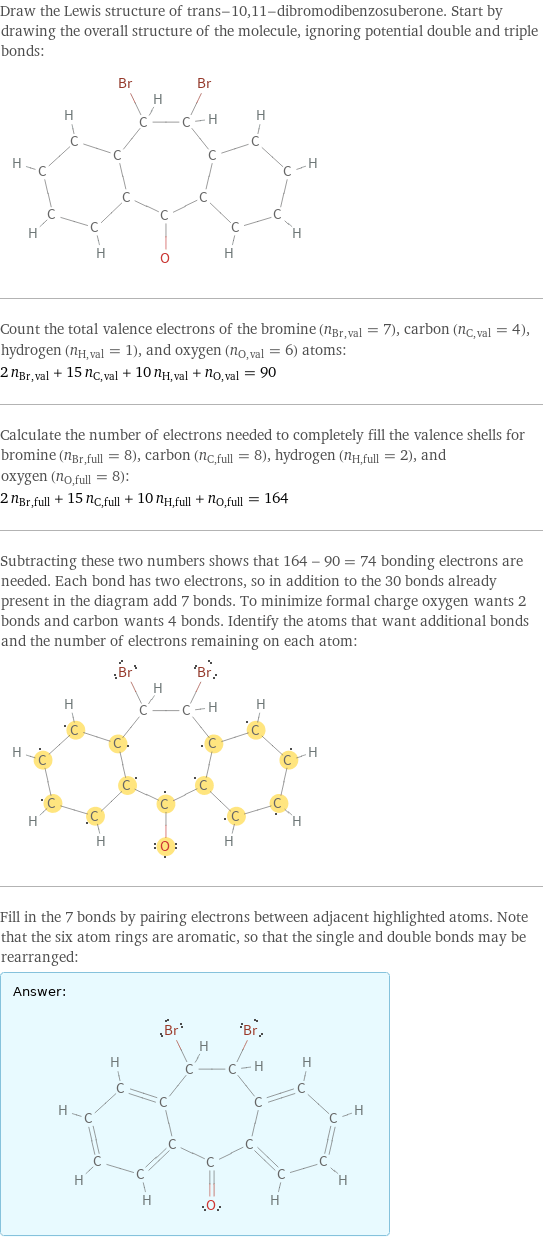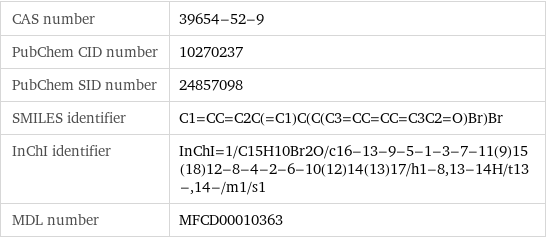Input interpretation

trans-10, 11-dibromodibenzosuberone
Chemical names and formulas
![formula | C_15H_10Br_2O name | trans-10, 11-dibromodibenzosuberone alternate names | 10, 11-dibromo-10, 11-dihydro-5H-dibenzo[a, d]cyclohepten-5-one mass fractions | Br (bromine) 43.7% | C (carbon) 49.2% | H (hydrogen) 2.75% | O (oxygen) 4.37%](../image_source/7a1d05b53f05f59203297cda52414100.png)
formula | C_15H_10Br_2O name | trans-10, 11-dibromodibenzosuberone alternate names | 10, 11-dibromo-10, 11-dihydro-5H-dibenzo[a, d]cyclohepten-5-one mass fractions | Br (bromine) 43.7% | C (carbon) 49.2% | H (hydrogen) 2.75% | O (oxygen) 4.37%
Lewis structure

Draw the Lewis structure of trans-10, 11-dibromodibenzosuberone. Start by drawing the overall structure of the molecule, ignoring potential double and triple bonds: Count the total valence electrons of the bromine (n_Br, val = 7), carbon (n_C, val = 4), hydrogen (n_H, val = 1), and oxygen (n_O, val = 6) atoms: 2 n_Br, val + 15 n_C, val + 10 n_H, val + n_O, val = 90 Calculate the number of electrons needed to completely fill the valence shells for bromine (n_Br, full = 8), carbon (n_C, full = 8), hydrogen (n_H, full = 2), and oxygen (n_O, full = 8): 2 n_Br, full + 15 n_C, full + 10 n_H, full + n_O, full = 164 Subtracting these two numbers shows that 164 - 90 = 74 bonding electrons are needed. Each bond has two electrons, so in addition to the 30 bonds already present in the diagram add 7 bonds. To minimize formal charge oxygen wants 2 bonds and carbon wants 4 bonds. Identify the atoms that want additional bonds and the number of electrons remaining on each atom: Fill in the 7 bonds by pairing electrons between adjacent highlighted atoms. Note that the six atom rings are aromatic, so that the single and double bonds may be rearranged: Answer: | |
3D structure

3D structure
Basic properties

molar mass | 366.05 g/mol phase | solid (at STP) melting point | 213 °C
Units

Chemical identifiers

CAS number | 39654-52-9 PubChem CID number | 10270237 PubChem SID number | 24857098 SMILES identifier | C1=CC=C2C(=C1)C(C(C3=CC=CC=C3C2=O)Br)Br InChI identifier | InChI=1/C15H10Br2O/c16-13-9-5-1-3-7-11(9)15(18)12-8-4-2-6-10(12)14(13)17/h1-8, 13-14H/t13-, 14-/m1/s1 MDL number | MFCD00010363